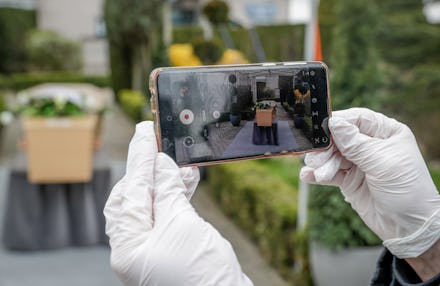The complicated grief of live-streamed funerals

The coronavirus pandemic has turned every aspect of our lives on its head, including how we mourn the dead. Concerns about COVID-19 have prompted many states, funeral homes, and cemeteries in the U.S. to restrict how funerals are run during the outbreak. Some locations limit the number of attendees to 10, require each person to maintain a certain distance from others, and keep family away from burials until the process is completely finished. It's a situation that requires a lot of understanding and flexibility from mourners and funeral directors alike. Many have tried whatever they could to accommodate social distancing rules and regulations, including one funeral home in Kentucky creating a drive-thru open-casket viewing for guests, allowing only close family members to step outside their cars.
Other funeral homes have turned to technology to solve their social distancing challenges. But the convenience of livestreaming comes with the unique pros and cons of the internet.
Setting up a funeral livestream isn't as easy as it sounds, according to a new Motherboard report. Not many funeral homes are prepared for streaming, leaving the set-up to the few family members attending the funeral. Naturally, this can result in brief interruptions as the designated 'techie' of the family deals with any technical difficulties.
The report also highlighted other wild and unexpected issues that have popped up with livestreaming. In one example, a user on Twitter expressed great frustration over YouTube apparently blocking the stream of a friend's funeral due to a copyright claim on music by Warner Music Group (WMG). In another example, a user asked for 1000 YouTube followers for a friend so he could reach the YouTube Live threshold required to livestream his mother's funeral on mobile.
Online behavior can also be a problem. The usual, in-person courtesy can fly out the window as guests pop in and out of a stream. Imagine people arriving at a memorial service going around to ask attendees about a completely different funeral. If this happened in-person, those people would most likely be escorted out for disturbing the mourners.
But on Facebook, where words are typed and folks are hidden behind screens, that's exactly what happened to one person's livestream as viewers tried to grieve.
Using Zoom to avoid those problems isn't a perfect solution, either. Not only does Zoom have glaring privacy issues, but there's also a growing number of incidents involving randos barging — or "zoombombing" — into streams and spouting racism, verbal harassment, and sometimes showing pornography that makes any open-to-the-public streams unsafe for viewers. To their credit, the company has since responded to the reports of abuse by enabling passwords to meetings by default for all users and taking the time to fix security holes on the platform.
Relying on technology for funerals isn't always a bad thing, though. Some friends and families are grateful to have a way to 'attend' a funeral when travel is restricted or if the health of a loved one might be compromised. Others have found positives in having a separate place, away from relatives, where they can work through their sorrow.
"I thought it would be distant and cold, but it was the exact opposite," Candida Rifkind told The New York Times. In fact, it was comforting in its own way: Usually, she hid her grief so she wouldn't be a burden to anyone else. However, in the privacy of her own home, she "didn't have to hold it together for anyone[.]"
Still, there are drawbacks. Those who rely on the warmth and comfort of hugs to soothe each others' sadness have complained that the restrictions have made funerals so cold and distant. Having only a small number of attendees for someone who affected many lives can also seem like an inappropriate way to say goodbye. An NBC article on the funeral of a lifelong activist, Lorena Borjas, who fought against transphobia and aided human trafficking victims, noted the "sense of anger" one friend felt as he watched her funeral online.
"She frequently accompanied sex workers to court appearances," NBC reported. "It was her way of humanizing some of society's most vulnerable members and comforting them during their darkest hours. But when Borjas died, no one would be there for her."
Funerals play an important societal role in helping people overcome grief and say goodbye to a loved one. And memorial services have been slowly but surely adjusting with technology as families live further and further apart. The pandemic has simply quickened the coming of livestreaming services for funerals, and its swift arrival drives further questions about what our funerals will look like in the future. Will we have to stop playing copyrighted music at memorial services? Will platforms make it easier to hide viewer count and metrics that can gnaw at the nerves in a way social media numbers often do?
There's good news for those who need each other for comfort and to reaffirm the lives of those lost: Traditional, in-person funerals are not likely to go away completely. But as long-distance becomes the norm for folks following work opportunities, streaming major life events will probably be more available as well. The answers to these questions are probably coming soon as we continue to refine how and what we livestream.